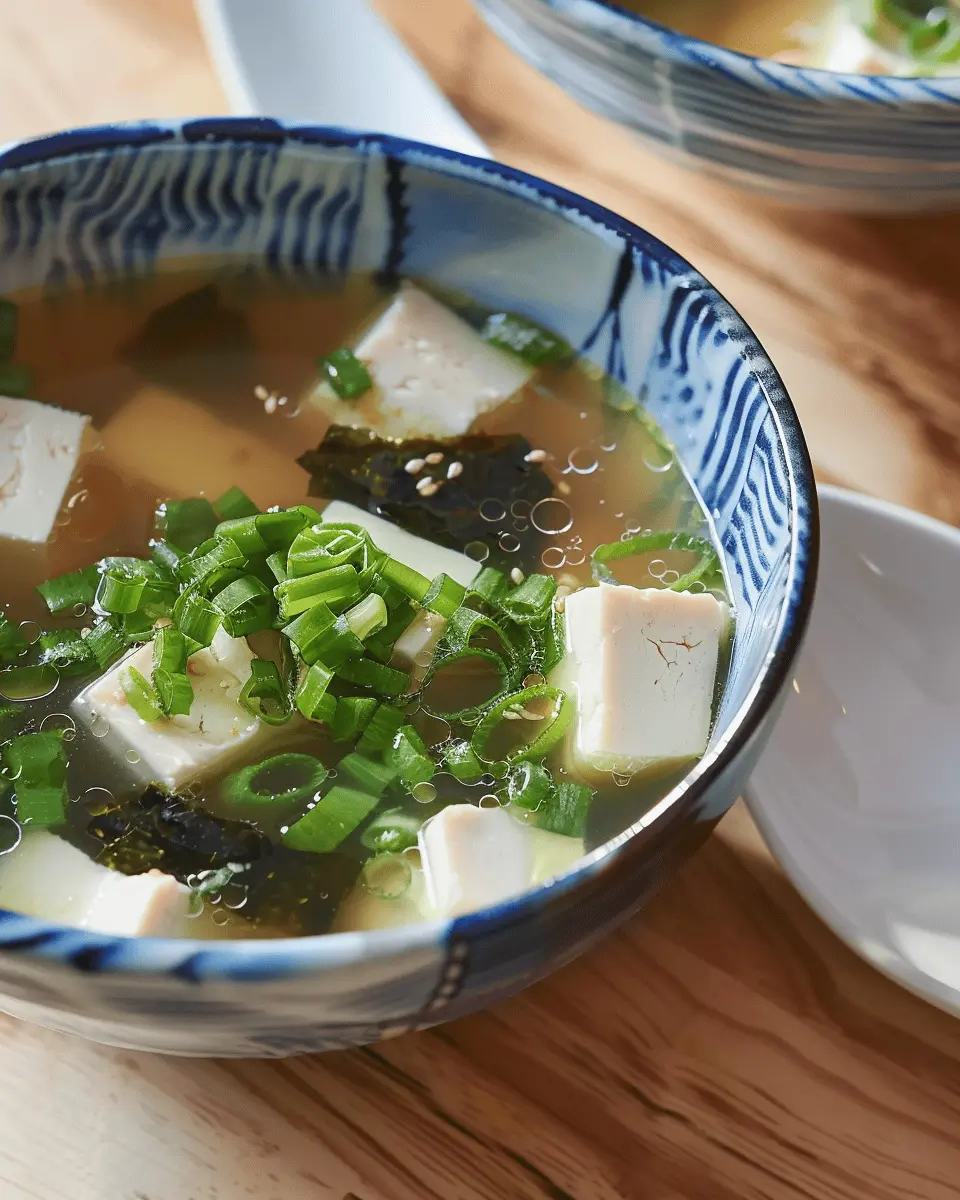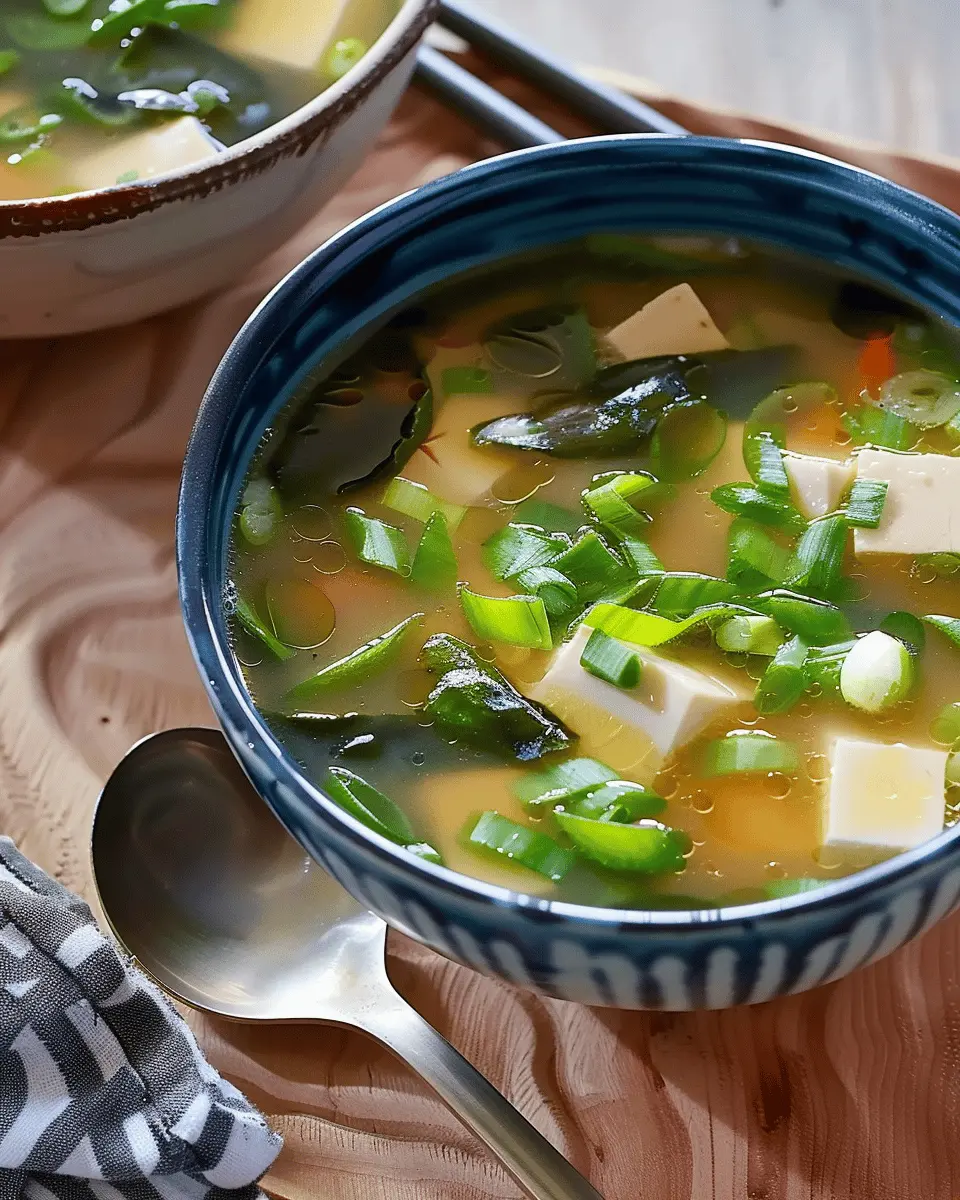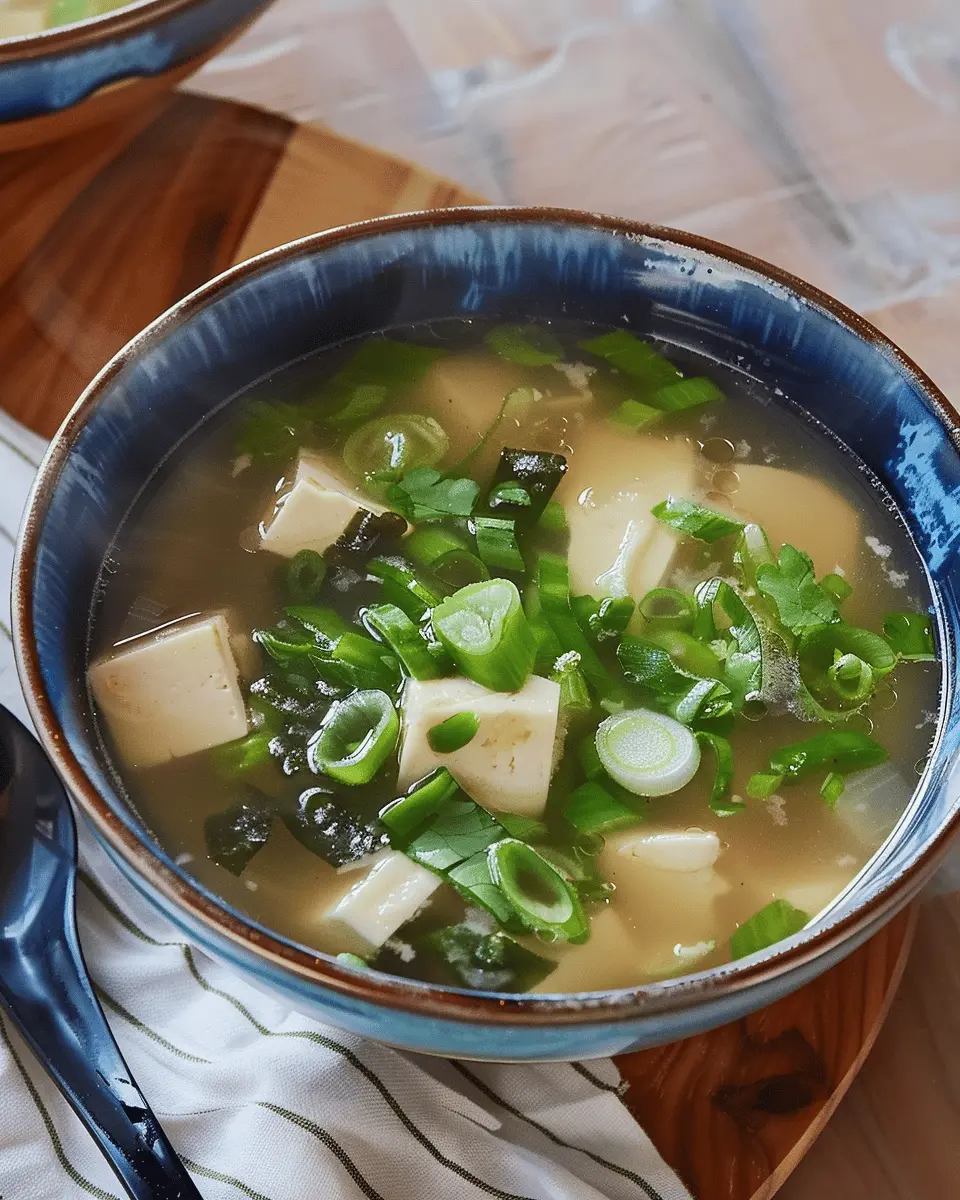Introduction to Miso Soup
If you’ve never had the delight of miso soup, you’re in for a treat! This Japanese staple is far more than a simple broth; it’s an exploration of flavors and textures that can elevate your meals to a whole new level. But what exactly is miso soup, and why should it be on your home-cooking radar?
What is Miso Soup?
At its core, miso soup is a traditional Japanese soup made with a base of miso paste—a fermented soybean product that’s rich in umami, the fifth taste that brings depth and savoriness to dishes. It’s typically prepared by dissolving this magical paste in dashi, a simple broth made from seaweed and fish flakes. This combination offers a harmonious balance of flavors while also being incredibly nutritious.
Making miso soup at home presents endless possibilities for customization. Want to keep it classic? Stick with tofu and seaweed. Looking for something heartier? Add vegetables like mushrooms, green onions, or even bits of Turkey Bacon or Chicken Ham for a protein boost. Each bowl can be a reflection of your culinary creativity!
Why Should You Make Miso Soup at Home?
-
Health Benefits: Miso soup is not only delicious but also healthful. Miso is packed with beneficial probiotics, which support a healthy gut. Moreover, the ingredients are often rich in vitamins, minerals, and antioxidants.
-
Quick and Easy: Whipping up a pot of miso soup can be done in under 15 minutes! It’s perfect for busy weeknights when you want something nourishing without spending hours in the kitchen.
-
Cost-Effective: With just a few simple ingredients, you can create a dish that’s both filling and satisfying. Plus, making it at home means you can control the quality and quantity of everything that goes in your bowl.
-
Culinary Exploration: There’s an exciting world of flavors waiting to be discovered. Experimenting with different types of miso (like red, white, or yellow) will introduce you to new taste sensations.
So why not gather the ingredients and give miso soup a try? You might just find it becoming a regular in your healthy eating repertoire! For more on the health benefits of fermented foods, check out this article from Healthline. Let’s dive into the recipe!

Ingredients for Miso Soup
Essential ingredients for a classic miso soup
Creating a delightful miso soup at home is easier than you think! To achieve that comforting, umami flavor, gather the following essential ingredients:
- Miso Paste: The star of the show! White or yellow miso provides a mild flavor, while red miso offers a bolder taste.
- Dashi Stock: This rich broth can be made from kombu (seaweed) and bonito flakes. Not a fan of fish? Seek out a vegetarian dashi instead.
- Tofu: Silken or firm tofu adds protein and creaminess to your soup.
- Green Onions: Chopped green onions bring freshness and color.
For a complete guide on choosing the right miso for your soup, consider this article from The Kitchn for expert advice.
Optional add-ins for flavor and texture
Once you’ve nailed the basics, feel free to get creative with optional add-ins:
- Seaweed: Wakame adds an authentic touch and a lovely chewy texture.
- Vegetables: Add mushrooms, spinach, or bok choy for extra nutrients and flavor.
- Protein: Turkey bacon or chicken ham can contribute a hearty element.
- Noodles: For a more filling soup, try adding soba or udon noodles.
Exploring these options not only enhances the experience but also personalizes your miso soup to suit your palate. Enjoy the journey of creating the perfect bowl!
Preparing Miso Soup
Making a delicious bowl of miso soup may sound intimidating if you’re new to cooking, but I promise it’s easier than you think! This comforting dish can be customized to your taste, and the process is straightforward. Let’s dive in together and explore how to prepare this traditional Japanese delight step by step, ensuring each mouthful warms your soul.
Gather your ingredients
Before you start, it’s always best to have everything at hand. The essentials for a simple miso soup include:
- 4 cups of water
- 2 tablespoons of dashi granules (for that umami kick)
- 3-4 tablespoons of miso paste (adjust to taste)
- 1 block of firm tofu (cubed)
- 2-3 green onions (sliced)
- Optional: seaweed, mushrooms, or vegetables like bok choy for added flavor and nutrition.
Consider visiting reputable sites like Just One Cookbook or Serious Eats for quality ingredients if your local store doesn’t have what you need.
Combine water and dashi granules
Once you’ve gathered your ingredients, it’s time to prep the base of your soup. Start by pouring 4 cups of water into a medium-sized pot and bringing it to a gentle boil over medium heat. While you’re waiting, measure out your dashi granules. As they dissolve in the hot water, they’ll infuse the broth with a deep, savory flavor — it’s what makes miso soup truly delightful!
If you’re curious, dashi is a classic Japanese stock made from kombu (kelp) and bonito flakes. But if you’re in a rush, dashi granules will work just as well. Feel free to learn more about dashi and its preparation here.
Whisk in the miso paste
Once your water and dashi mixture is boiling, it’s time to add the star of the show: the miso paste. Taking a few tablespoons of miso, add it to a separate bowl. Use a ladleful of your hot broth to whisk the paste until it’s smooth and free of lumps. Then, gradually pour this mixture into the pot while stirring gently.
Here’s a tip: avoid boiling the soup after adding miso, as this can diminish its unique flavors and health benefits. Instead, lower the heat just enough to keep it warm.
Stir in the tofu
When your miso has melded beautifully into the broth, it’s time to introduce your tofu. Gently add the cubed tofu to your pot, ensuring they don’t break apart too much. Tofu is not just a protein source; it also absorbs all those delicious flavors, enhancing the overall taste of your miso soup. Allow the mixture to simmer for about 5 minutes, which gives everything a chance to harmonize.
Add the green onions and simmer
Last but not least, it’s time to add the finishing touches to your miso soup. Toss in the sliced green onions, which add a refreshing bite and beautiful color to your dish. Let the soup simmer for another minute or so, just enough for the onions to soften ever so slightly while still retaining their vibrant flavor.
Once everything is combined, take a moment to savor the warm, earthy aroma wafting from your pot. You’ve just created a comforting, nourishing, and traditional miso soup that is bound to be a hit.
Now, grab a bowl, ladle in your delightful creation, and enjoy! Don’t forget — the beauty of miso soup lies in its adaptability. Experiment with additions like mushrooms or vegetables as you gain confidence in making it your own. Happy cooking!

Variations on Miso Soup
Miso soup is a versatile dish that invites creativity in the kitchen. While the classic recipe is always a delight, exploring variations can help keep meals exciting. Here are a few delicious alternatives that you can easily whip up.
Miso Soup with Mushrooms
One fantastic twist on traditional miso soup features an array of mushrooms. Shiitake, enoki, or even oyster mushrooms add a savory depth and an earthy note to the broth. Simply sauté your selected mushrooms before adding them to the soup base; this enhances their flavor and texture. Plus, mushrooms are packed with nutrients, making this variation a health-conscious choice. Need more inspiration? Check out this mushroom benefits article for an insightful read!
Miso Soup with Seaweed
For those who want to amplify the umami factor, consider making miso soup with seaweed. Kombu is a popular choice, not only for its flavor but also for its rich mineral content. Adding wakame provides a lovely texture and complements the broth beautifully. Just a handful of seaweed is enough to brighten your soup and introduce a splendid texture. Research shows that incorporating seaweed into your diet can promote heart health—perfect for those busy, health-conscious professionals!
Miso Soup with Vegetables
Lastly, let’s not forget the vibrant option of miso soup with a medley of vegetables. Carrots, spinach, and green onions create a colorful, nutrient-rich bowl that feels comforting yet light. Not only does this variation allow you to use up leftover veggies, but it also caters to those looking for a wholesome, plant-based meal. Feel free to experiment with seasonal vegetables to add even more variety!
Whichever version you choose, miso soup offers endless possibilities! So gather your favorite ingredients and let your culinary creativity shine.
Cooking Tips and Notes for Miso Soup
Choosing the Right Miso Paste
When making miso soup, the type of miso paste you choose can make all the difference. There are primarily three types: white (shiro), yellow (shinshu), and red (aka). White miso is milder and sweeter, while red miso has a deeper and saltier flavor. Yellow miso strikes a balance between the two. Feel free to experiment! You can also mix different varieties to create a unique taste. For more insights on miso types, check out Miso Master.
Adjusting Consistency and Flavor
The beauty of miso soup lies in its adaptability. If you find your soup too thick or salty, simply add more broth or water to balance the flavor. Conversely, if you prefer a richer taste, consider adding more miso paste—just dissolve it in a small amount of warm broth first to ensure it blends smoothly. Don’t hesitate to tailor your soup to your liking. Not sure where to start? Start with one tablespoon per cup of liquid, then adjust to taste!

Serving Suggestions for Miso Soup
Pairing Miso Soup with Other Dishes
Miso soup is a delightful starter that pairs beautifully with a variety of dishes. Think about serving it alongside sushi rolls, teriyaki chicken, or even a refreshing salad. The warm, umami flavor of miso soup complements the freshness of sushi and the sweetness of teriyaki beautifully. For something heartier, try it with a bowl of ramen or udon noodles. When you’re hosting a gathering, consider offering a tea set with your miso soup to provide a lighter touch that enhances its flavors.
Creative Serving Ideas
Get a little inventive with how you serve your miso soup. Instead of a typical bowl, try using small cups for a tasting menu or even shot glasses for a fun appetizer. You can also incorporate various toppings like sliced green onions, tofu, or seaweed to create a unique experience for your guests. Want to add a personal touch? Consider garnishing with edible flowers or a drizzle of sesame oil for a visual appeal.
If you’re interested in exploring more flavors, check out Serious Eats for additional ideas and insights on transforming this classic soup into your own culinary masterpiece!
Time Breakdown for Miso Soup
Preparation time
Getting ready to whip up a delicious miso soup takes around 10 minutes. Gather your ingredients: miso paste, dashi broth, tofu, green onions, and any additional ingredients you fancy. It’s amazing how a bit of chopped seaweed or veggies can elevate your soup!
Cooking time
The actual cooking part takes just about 5 minutes. Once you combine the broth and miso, let it simmer with your chosen ingredients. This is where the magic happens, as the flavors meld together beautifully.
Total time
In total, you’re looking at a quick 15 minutes from start to finish. Perfect for those busy evenings when you crave a comforting bowl of miso soup!
For a deeper dive into the health benefits of miso, consider exploring resources like Healthline for expert perspectives.
Nutritional Facts for Miso Soup
When considering a nourishing miso soup, it’s good to know what you’re getting in your bowl. Here’s a friendly breakdown of its key nutritional facts:
Calories per serving
A typical serving of miso soup contains around 40 calories. This makes it a low-calorie option, ideal for a comforting appetizer or a light meal.
Protein content
You’ll find about 3 grams of protein in a serving, thanks to the added tofu and seaweed. It’s a great source of plant-based protein that can help fuel your day. If you’re looking to amp up your protein intake, consider adding chicken ham or turkey bacon!
Sodium levels
It’s essential to keep an eye on sodium, as miso soup can contain around 800 mg per serving, primarily from miso paste. While it can be quite savory, adjusting the amount of miso or opting for low-sodium varieties helps manage salt levels. For more detailed nutritional insights, check official resources like the USDA FoodData Central.
Enjoy crafting your own miso soup while keeping your nutritional goals in check!
FAQs about Miso Soup
How can I make miso soup vegetarian?
Making miso soup vegetarian is both simple and delicious! You can replace the traditional dashi (which often contains fish) with a vegetable broth. Consider using ingredients like kombu (dried sea kelp) and shiitake mushrooms to enhance the umami flavor without the meat. When it comes to the miso paste, opt for a variety that’s labeled as vegetarian or vegan. Adding tofu, scallions, and seasonable veggies will round out the dish beautifully. Not sure where to start? Check out this vegetarian dashi recipe for a perfect base!
Can I freeze miso soup?
While you can technically freeze miso soup, it’s not always the best option. The miso paste can separate when thawed, impacting the texture. If you still want to freeze it, consider excluding the tofu and other ingredients that may not freeze well. Instead, freeze the broth, and when you’re ready to enjoy it, simply reheat and add fresh tofu and veggies. For tips on freezing soups, delve into this helpful freezing soup guide.
What should I serve with miso soup?
Serving miso soup can elevate your meal in delightful ways! Pair it with steamed rice, sushi rolls, or a light salad for a balanced and satisfying spread. It works beautifully as a warm starter before a main dish like teriyaki chicken or even a hearty grain bowl. Feel free to experiment! You can find inspiration in articles like this one on Japanese side dishes that complement soup effortlessly.
By exploring these questions, you’re well on your way to mastering miso soup in all its variations!
Conclusion on Miso Soup
Recap and Encouragement to Try Making Miso Soup at Home
Miso soup is a wonderfully versatile dish that can easily be tailored to your taste. With just a few essential ingredients like miso paste, tofu, and dashi, you can whip up this comforting soup in no time. Not only is it delicious, but it’s also packed with nutrients, making it a perfect addition to your healthy eating habits.
I encourage you to give making miso soup at home a try! The process is simple, and the satisfaction of enjoying your own creation is unbeatable. For more tips and variations on this recipe, check out resources like Fine Cooking or Serious Eats. Experiment, have fun, and don’t hesitate to customize ingredients to make this dish your own!
PrintMiso Soup: Easy and Delicious Recipe for a Cozy Night In
A warm and comforting miso soup recipe perfect for a cozy night in.
- Prep Time: 10 minutes
- Cook Time: 10 minutes
- Total Time: 20 minutes
- Yield: 4 servings 1x
- Category: Soup
- Method: stovetop
- Cuisine: Japanese
- Diet: vegetarian
Ingredients
- 4 cups dashi stock
- 3 tablespoons miso paste
- 1 cup silken tofu, cubed
- 1/2 cup green onions, chopped
- 1/4 cup seaweed (wakame), rehydrated
Instructions
- In a pot, heat dashi stock over medium heat.
- In a small bowl, mix miso paste with a bit of the warm stock until smooth.
- Add the miso mixture back into the pot and stir well.
- Gently add tofu and wakame to the pot.
- Simmer for 2-3 minutes, then add green onions just before serving.
Notes
- For a richer flavor, you can add mushrooms or other vegetables.
- Adjust the amount of miso paste according to your taste preference.
Nutrition
- Serving Size: 1 cup
- Calories: 100
- Sugar: 1g
- Sodium: 500mg
- Fat: 3g
- Saturated Fat: 0g
- Unsaturated Fat: 0g
- Trans Fat: 0g
- Carbohydrates: 10g
- Fiber: 1g
- Protein: 5g
- Cholesterol: 0mg
Keywords: miso soup, easy recipes, cozy meals












